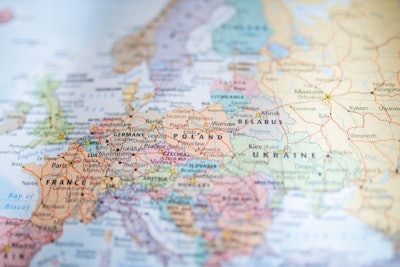
Farmers across Eastern Europe are falling into despair, seeing no signs of an upcoming price relief in the feed market, where one crisis comes after another.
In the wake of the Russian invasion of Ukraine, feed prices skyrocketed in Eastern Europe in 2022. Lech Kołakowski, Polish deputy agricultural minister, estimated that feed price was 30% to 40% higher in the country compared with the previous year and 50% to 70% higher compared with 2020.
Kołakowski reported that the average price of poultry feed stood at PLN2,311 (US$468) per ton, 41% higher than in the previous year, pig feed at PLN2,190 per ton, up 27% compared with 2021, and cattle feed at PLN2,289 per ton, 30% more than last year.
In March-April, some farmers’ associations in Poland, Europe’s largest poultry exporter, raised concerns that amid a lack of Ukrainian grain on the global market, farmers could face a crisis different from anything they had seen before. It was suggested that, under a pessimistic scenario, the question would not only be about price hikes but whether farmers would have enough feed for their animals.
However, these fears have not materialized, primarily because Ukrainian grain eventually managed to find a way to the European market through the land border with Poland and Hungary. Kołakowski said that, in April, Poland imported more corn and tripled soybean imports from Ukraine compared with the same period of the previous year.
However, the price relief on the feed market is not anticipated, as farmers now voice concerns over huge losses of harvest in September-October, owing to abnormal weather conditions. Persistent heat waves affected almost all countries of Europe in June-July, in some parts causing wildfires, evacuations and heat-related deaths.
Lost pastures
“The drought we see at the moment has not affected some crops, for example, wheat, barley, rapeseed, and peas. But, we are still expecting a disaster with the harvest of other crops such as corn, sugar beet, and sunflower,” said Emil Macho, head of the Slovak Chamber of Agriculture and Food, adding that this season the demand for feed is likely to surge because the drought destroyed most pastures in the country.
“Our fields and meadows where cattle used to graze are dry. We had literally to move the animals from these fields into barns,” he added.
Slovakia is likely to lose nearly 50% of corn this year because of the drought, Macho said, admitting that this factor is expected to raise feed prices further and accelerate food inflation, especially because all neighboring countries face the same challenge.
“Slovakia is not an abandoned island. We are part of the EU, and European farmers experience the same problems. While food inflation is currently estimated at 16%, we have predicted that the prices of commodities and food will soar due to the drought. So, the food inflation is likely to reach 20% in September,” Macho said.
Due to the drought, a new wave of upward price rally on the feed market has prompted pig farmers to scale down their business or suspend operation.
Some of the worst crises ever
Bora Šuljmanac, a pig farmer from Sremska Mitrovica, Serbia, said things had never been so bad in the industry, with most businesses operating at zero profitability or even sustaining losses.
“I fatten about 5,000 pigs a year and now barely cover the cost of feeding. And I wouldn’t even be able to do that if I didn’t produce cereals. This means that I don’t have to buy expensive feedstuff, but the earnings are still zero,” said Šuljmanac.
Serbian livestock farmers are hit by a mix of problems, including expensive fuel and rising grain prices due to substantial exports to neighboring countries, but the drought makes the current crisis unprecedented, said Zoran Milićević, president of the Assembly of Agricultural Producers of Serbia.
“Due to the drought, the pasture grass has been burned. Cattle can’t graze out there any longer,” Milićević said.
The food inflation in Eastern Europe has already started taking on toll on consumption, as the average wages in the region are traditionally lower than in the western part of the continent.
Bojan Matijević, co-owner of the Serbian pig company Matijević, estimated that domestic meat consumption slumped by nearly 20% over the past one to two years.
“In the last year, pork, chicken and beef have risen in price by 30% in retail, despite the drop in consumption. Consumers have revised their budgets because their purchasing power plummeted, as wages are not rising by 30% per year,” said Matijević.
Throwing a helping hand
The picture is even worse in the neighboring Montenegro, where inflation has recently hit a 15-year high, and the country is likely to fall into an economic crisis in the next few months due to a lack of feedstuff and energy.
Vladimir Joković, agricultural minister, explained that, to meet the domestic demand, the authorities have concluded “extraordinary agreements” with Serbia. Speaking recently at the Parliament of Montenegro, he disclosed that the country “will be given a priority together with North Macedonia, Bosnia and Herzegovina and Albania” in the procurement of basic foodstuffs from Serbia in the second half of 2022.
“If Montenegro decides to establish state commodity reserves, Serbia promised that in three to four months we can obtain reserves of the basic foodstuffs of flour, oil and sugar,” said Joković, adding that some deal has also been achieved on the import of animal feed from Serbia.
In 2022, the price of animal feed has doubled in Montenegro, the agricultural ministry estimated, citing a lack of Ukrainian grain and the summer weather abnormalities as the main reasons. However, some of Montenegro’s politicians voiced concerns that relying on Serbia is a bad idea, especially since the country itself struggles against soaring food inflation.
“I think that this optimism of Joković is not based on facts, but on wishes,” Mirko Stanić from the Social Democratic Party told Radio Free Europe, adding that a country should never rely on one source of food. “I’m afraid that the citizens of Montenegro will suffer the consequences in the end.”
The Serbian government has lifted the ban on the export of wheat and corn, allowing free export until the beginning of autumn of 2022, when a new stock assessment is scheduled. Some Serbian farmers call to introduce grain export restrictions to bolster the domestic meat and milk industry. If taken, this measure could plunge the Balkan feed industry into chaos.
Alternative reality
In the meantime, in neighboring Ukraine feed industry lives in a completely different reality, having some of the world’s lower grain prices but experiencing a slump in demand due to devastating losses in the livestock population.
“The Ukrainian livestock industry suffered heavy losses during these five months of the war. A large number of companies in the East and South found themselves in an almost hopeless situation,” said Maxim Gopka, an analyst of the Ukrainian Agribusiness Club.
The estimated number of animals that have died since the beginning of the Russia-Ukraine conflict is 42,000 heads of sheep and goats, 92,000 heads of cattle, 258,000 pigs, and over 5.7 million poultry, a recent research conducted by the Kyiv School of Economy showed. The estimated value of livestock loss damages exceeds $136 million.
Gopka said that the feedstuff prices remain low this season, as Ukrainian seaports were under siege for several months, which created a substantial oversupply in the domestic grain market. A grain export deal signed by Ukraine, Russia and Turkey promises to bring balance back to the Ukrainian grain market, but it would take several months to see the effect.











